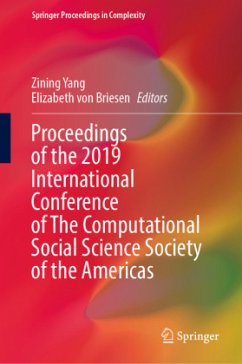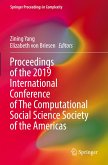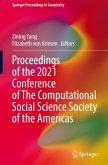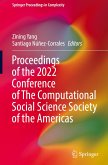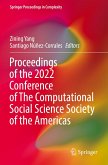Proceedings of the 2019 International Conference of The Computational Social Science Society of the Americas
Herausgegeben:Yang, Zining; von Briesen, Elizabeth
Proceedings of the 2019 International Conference of The Computational Social Science Society of the Americas
Herausgegeben:Yang, Zining; von Briesen, Elizabeth
- Gebundenes Buch
- Merkliste
- Auf die Merkliste
- Bewerten Bewerten
- Teilen
- Produkt teilen
- Produkterinnerung
- Produkterinnerung
This book presents the latest research into CSS methods, uses, and results, as presented at the 2019 annual conference of the CSSSA. This conference was held in Santa Fe, New Mexico, October 24 - 27, 2019, at the Drury Plaza Hotel. What follows is a diverse representation of new results and approaches for using the tools of CSS and agent-based modeling (ABM) for exploring complex phenomena across many different domains. Readers will therefore not only have the results of these specific projects on which to build, but will also gain a greater appreciation for the broad scope of CSS, and have a…mehr
Andere Kunden interessierten sich auch für
![Proceedings of the 2019 International Conference of The Computational Social Science Society of the Americas Proceedings of the 2019 International Conference of The Computational Social Science Society of the Americas]() Proceedings of the 2019 International Conference of The Computational Social Science Society of the Americas134,99 €
Proceedings of the 2019 International Conference of The Computational Social Science Society of the Americas134,99 €![Proceedings of the 2021 Conference of The Computational Social Science Society of the Americas Proceedings of the 2021 Conference of The Computational Social Science Society of the Americas]() Proceedings of the 2021 Conference of The Computational Social Science Society of the Americas192,59 €
Proceedings of the 2021 Conference of The Computational Social Science Society of the Americas192,59 €![Proceedings of the 2021 Conference of The Computational Social Science Society of the Americas Proceedings of the 2021 Conference of The Computational Social Science Society of the Americas]() Proceedings of the 2021 Conference of The Computational Social Science Society of the Americas97,99 €
Proceedings of the 2021 Conference of The Computational Social Science Society of the Americas97,99 €![Proceedings of the 2023 International Conference of The Computational Social Science Society of the Americas Proceedings of the 2023 International Conference of The Computational Social Science Society of the Americas]() Proceedings of the 2023 International Conference of The Computational Social Science Society of the Americas164,99 €
Proceedings of the 2023 International Conference of The Computational Social Science Society of the Americas164,99 €![Proceedings of the 2022 Conference of The Computational Social Science Society of the Americas Proceedings of the 2022 Conference of The Computational Social Science Society of the Americas]() Proceedings of the 2022 Conference of The Computational Social Science Society of the Americas164,99 €
Proceedings of the 2022 Conference of The Computational Social Science Society of the Americas164,99 €![Proceedings of the 2022 Conference of The Computational Social Science Society of the Americas Proceedings of the 2022 Conference of The Computational Social Science Society of the Americas]() Proceedings of the 2022 Conference of The Computational Social Science Society of the Americas119,99 €
Proceedings of the 2022 Conference of The Computational Social Science Society of the Americas119,99 €![Encyclopedia of Complexity and Systems Science Encyclopedia of Complexity and Systems Science]() Robert A Meyers (Editor-in-chief)Encyclopedia of Complexity and Systems Science603,99 €
Robert A Meyers (Editor-in-chief)Encyclopedia of Complexity and Systems Science603,99 €-
-
-
This book presents the latest research into CSS methods, uses, and results, as presented at the 2019 annual conference of the CSSSA. This conference was held in Santa Fe, New Mexico, October 24 - 27, 2019, at the Drury Plaza Hotel. What follows is a diverse representation of new results and approaches for using the tools of CSS and agent-based modeling (ABM) for exploring complex phenomena across many different domains. Readers will therefore not only have the results of these specific projects on which to build, but will also gain a greater appreciation for the broad scope of CSS, and have a wealth of case-study examples that can serve as meaningful exemplars for new research projects and activities. The Computational Social Science Society of the Americas (CSSSA) is a professional society that aims to advance the field of CSS in all its areas, from fundamental principles to real-world applications, by holding conferences and workshops, promoting standards of scientificexcellence in research and teaching, and publishing novel research findings.
Produktdetails
- Produktdetails
- Springer Proceedings in Complexity
- Verlag: Springer / Springer International Publishing / Springer, Berlin
- Artikelnr. des Verlages: 978-3-030-77516-2
- Seitenzahl: 399
- Erscheinungstermin: 19. August 2021
- Englisch
- Abmessung: 27mm x 155mm x 235mm
- ISBN-13: 9783030775162
- Artikelnr.: 61652660
- Herstellerkennzeichnung Die Herstellerinformationen sind derzeit nicht verfügbar.
- Springer Proceedings in Complexity
- Verlag: Springer / Springer International Publishing / Springer, Berlin
- Artikelnr. des Verlages: 978-3-030-77516-2
- Seitenzahl: 399
- Erscheinungstermin: 19. August 2021
- Englisch
- Abmessung: 27mm x 155mm x 235mm
- ISBN-13: 9783030775162
- Artikelnr.: 61652660
- Herstellerkennzeichnung Die Herstellerinformationen sind derzeit nicht verfügbar.
Dr. Zining Yang is Senior Manager at Southern California Edison. She also works as Clinical Professor at Claremont Graduate University and Associate Director at the TransResearch Consortium. She sits on the Board of the Computational Social Science Society of the Americas (CSSSA), and serves as Scientific Advisory Board Member for Human Factors and Simulations. Dr. Yang received her Ph.D. in Computational and Applied Mathematics and Political Economy from Claremont Graduate University in 2015. Her research interests include Data Analytics, Machine Learning, Modeling and Simulation, Complex Adaptive Systems, Agent-Based Models, and Network Analysis. Dr. Yang has been published numerous times in the fields of Computer Science, Economics, Public Policy, and Political Science. She has been identified as an outstanding researcher by the government, worked on a National Science Foundation-sponsored project, and won multiple awards from various organizations, including the Ministryof Education of the People's Republic of China; International Social Computing, Behavioral Modeling and Prediction; and the International Institute of Informatics and Systemics.
Dr. Elizabeth von Briesen is an Assistant Professor of Computer Science at Elon University, and is a member of the board of the Computational Social Science Society of the Americas. She received her Ph.D. in Computing & Informatics from the University of North Carolina at Charlotte in 2020. Her research interests are focused on the study of complex adaptive systems using computational techniques, particularly with respect to social systems experiencing identity-based conflict. She primarily works with agent-based models, and performs data mining and sentiment analysis to inform those simulations. Finally, in her current position, Dr. von Briesen strives to contribute toward an evolving undergraduate computer science experience through research, service, and high-quality, innovative teaching.
Dr. Elizabeth von Briesen is an Assistant Professor of Computer Science at Elon University, and is a member of the board of the Computational Social Science Society of the Americas. She received her Ph.D. in Computing & Informatics from the University of North Carolina at Charlotte in 2020. Her research interests are focused on the study of complex adaptive systems using computational techniques, particularly with respect to social systems experiencing identity-based conflict. She primarily works with agent-based models, and performs data mining and sentiment analysis to inform those simulations. Finally, in her current position, Dr. von Briesen strives to contribute toward an evolving undergraduate computer science experience through research, service, and high-quality, innovative teaching.
Chapter 1 - Encoding Protest Duration in an Agent-Based Model as Characteristic PhaseTransitions (Brian Goode and Bianica Pires ).- Chapter 2 - System-wide Policy Solutions for Water Scarcity Issues (Saeed Langarudi, Ashley Page, Connie Maxwell, Yining Bai, Babak Bahaddin, and Alexander Fernald).- Chapter 3 - More or Faster? Technology Subsidy Policy, Additional Adoptions, and Accelerated Diffusion (D. Cale Reeves, and Varun Rai).- Chapter 4 - Assessing the Potential of Crowd-shipping for Food Rescue Logistics Using Agent-based Modeling (Anuj Mittal, Nilufer Oran Gibson, and Caroline Krejci).- Chapter 5 - The Cat and Mouse Dynamics of Getting Around the Law (Daria Roithmayr, Fei Fang, and Justin Chin).- Chapter 6 - Social Primitives: Exploring Spark of Life Collective Behavior in Agent Based Models (Srikanth Mudigonda, and Milton Friesen).- Chapter 7 - Wealth dynamics in the presence of network structure and primitive cooperation ( Rajesh Venkatachalapathy, Stephen Davies, and William Nehrboss).- Chapter 8 - Resistance of Communities Against Conspiracies ( Amirarsalan Rajabi, Seyyedmilad Talebzadehhosseini, and Ivan Garibay).- Chapter 9 - Capturing the Production of Innovative Ideas: An Online Social Network Experiment and "Idea Geography" Visualization ( Yiding Cao, Yingjun Dong, Minjun Kim, Neil Maclaren, Ankita Kulkarni, Shelley Dionne, Francis Yammarino, and Hiroki Sayama).- Chapter 10 - An Agent-Based Model to Understand Simple Theory of Mind: Belief Representation Systematic Approach (BRSA) ( Zahrieh Yousefi, Dietmar Heinke, Ian Apperly, and Peer-Olaf Siebers).- Chapter 11 - A Model of Emergence featuring Social Mechanisms of Information Compression (Loren Demerath, James Reid, and E. Dante Suarez).- Chapter 12 - Social viscosity, fluidity and turbulence in collective perceptions of color: an agent-based model of color scale convergence (Juan Salamanca, and Santiago Núñez-Corrales).-Chapter 13 - Abandoned Battlegrounds An Agent-Based Model of Campaign Behavior Change with Proportional Allocation of Electors (John Silver: Electoral College).- Chapter 14 - Global News Sentiment Analysis (Eric Castellanos, Hang Xie, and Paul Brenner).- Chapter 15 - Corruption and the effects of influence within social networks: An agent-based model of the Lava Jato scandal (Amira Al-Khulaidy, and Valentin Vergara Hidd).- Chapter 16 - The Degree-Dependent Threshold Model: Towards a Better Understanding of Opinion Dynamics on Online Social Networks ( *Ece Mutlu, and Ivan Garibay).- Chapter 17 - Inside the Mind of the Nonfiler: An Agent-Based Modeling Approach (Melissa Vigil, Thi Nguyen, and Ellen Badgley).- Chapter 18 - A Complex-Systems Agenda for Influencing Policy Analysis ( Paul Davis, Tim McDonald, Ann Pendleton-Jullian, Angela O'Mahony, and Osonde Osoba).- Chapter 19 - The Evolution of Sharing in the Dictator Game (Jeffrey Schank).- Chapter 20 - Capturing the Effects of Gentrification on Property Values: An Agent-Based Modeling Approach (Niloofar Bagheri-Jebelli, Andrew T. Crooks, and William G. Kennedy).- Chapter 21 - Exogenous Shocks Lead to Increased Responsiveness and Shifts in Sentimental Resilience in Online Discussions (Chathika Gunaratne, Subash Ray, Caroline Alves, and Maria Waldl).- Chapter 22 - Decision-Adjusted Modeling for Imbalanced Classification: Predicting Rooftop Solar Panel Adoption in Rural Virginia (Zhihao Hu, Xinwei Deng, Achla Marathe, Samarth Swarup and Anil Vullikanti).- Chapter 23 - An agent-based model of social fabric seen as an emergent behavior in cities (Gamaliel Palomo, Mario Siller, Arnaud Grignard, and Luis Alonso).- Chapter 24 - Modifying human facial impression ( Amanda Song, Chad Atalla, Bartholomew Tam, Linjie Li, and Garrison Cottrell).- Chapter 25 - Modeling Genocide: An Agent-Based Model of Bystander Motivation and Societal Restraints (Elizabeth von Briesen, Amy Canevello, Samira Shaikh, John Cox, and Mirsad Hadzikadic).- Chapter 26 - Deep Agent: A Framework for InformationSpread and Evolution in Social Networks ( Ivan Garibay, Toktam Oghaz, and Niloofar Yousefi).- Chapter 27 - Negative Influence Gradients Lead to Lowered Information Processing Capacity on Social Networks ( Nisha Baral, Chathika Gunaratne, Chathura Jayalath, William Rand, Chathurani Senevirathna, and Ivan Garibay).- Chapter 28 - Complex Systems Analysis of Transplant Center Performance Metrics (David Dixon).
Chapter 1 - Encoding Protest Duration in an Agent-Based Model as Characteristic PhaseTransitions (Brian Goode and Bianica Pires ).- Chapter 2 - System-wide Policy Solutions for Water Scarcity Issues (Saeed Langarudi, Ashley Page, Connie Maxwell, Yining Bai, Babak Bahaddin, and Alexander Fernald).- Chapter 3 - More or Faster? Technology Subsidy Policy, Additional Adoptions, and Accelerated Diffusion (D. Cale Reeves, and Varun Rai).- Chapter 4 - Assessing the Potential of Crowd-shipping for Food Rescue Logistics Using Agent-based Modeling (Anuj Mittal, Nilufer Oran Gibson, and Caroline Krejci).- Chapter 5 - The Cat and Mouse Dynamics of Getting Around the Law (Daria Roithmayr, Fei Fang, and Justin Chin).- Chapter 6 - Social Primitives: Exploring Spark of Life Collective Behavior in Agent Based Models (Srikanth Mudigonda, and Milton Friesen).- Chapter 7 - Wealth dynamics in the presence of network structure and primitive cooperation ( Rajesh Venkatachalapathy, Stephen Davies, and William Nehrboss).- Chapter 8 - Resistance of Communities Against Conspiracies ( Amirarsalan Rajabi, Seyyedmilad Talebzadehhosseini, and Ivan Garibay).- Chapter 9 - Capturing the Production of Innovative Ideas: An Online Social Network Experiment and "Idea Geography" Visualization ( Yiding Cao, Yingjun Dong, Minjun Kim, Neil Maclaren, Ankita Kulkarni, Shelley Dionne, Francis Yammarino, and Hiroki Sayama).- Chapter 10 - An Agent-Based Model to Understand Simple Theory of Mind: Belief Representation Systematic Approach (BRSA) ( Zahrieh Yousefi, Dietmar Heinke, Ian Apperly, and Peer-Olaf Siebers).- Chapter 11 - A Model of Emergence featuring Social Mechanisms of Information Compression (Loren Demerath, James Reid, and E. Dante Suarez).- Chapter 12 - Social viscosity, fluidity and turbulence in collective perceptions of color: an agent-based model of color scale convergence (Juan Salamanca, and Santiago Núñez-Corrales).-Chapter 13 - Abandoned Battlegrounds An Agent-Based Model of Campaign Behavior Change with Proportional Allocation of Electors (John Silver: Electoral College).- Chapter 14 - Global News Sentiment Analysis (Eric Castellanos, Hang Xie, and Paul Brenner).- Chapter 15 - Corruption and the effects of influence within social networks: An agent-based model of the Lava Jato scandal (Amira Al-Khulaidy, and Valentin Vergara Hidd).- Chapter 16 - The Degree-Dependent Threshold Model: Towards a Better Understanding of Opinion Dynamics on Online Social Networks ( *Ece Mutlu, and Ivan Garibay).- Chapter 17 - Inside the Mind of the Nonfiler: An Agent-Based Modeling Approach (Melissa Vigil, Thi Nguyen, and Ellen Badgley).- Chapter 18 - A Complex-Systems Agenda for Influencing Policy Analysis ( Paul Davis, Tim McDonald, Ann Pendleton-Jullian, Angela O'Mahony, and Osonde Osoba).- Chapter 19 - The Evolution of Sharing in the Dictator Game (Jeffrey Schank).- Chapter 20 - Capturing the Effects of Gentrification on Property Values: An Agent-Based Modeling Approach (Niloofar Bagheri-Jebelli, Andrew T. Crooks, and William G. Kennedy).- Chapter 21 - Exogenous Shocks Lead to Increased Responsiveness and Shifts in Sentimental Resilience in Online Discussions (Chathika Gunaratne, Subash Ray, Caroline Alves, and Maria Waldl).- Chapter 22 - Decision-Adjusted Modeling for Imbalanced Classification: Predicting Rooftop Solar Panel Adoption in Rural Virginia (Zhihao Hu, Xinwei Deng, Achla Marathe, Samarth Swarup and Anil Vullikanti).- Chapter 23 - An agent-based model of social fabric seen as an emergent behavior in cities (Gamaliel Palomo, Mario Siller, Arnaud Grignard, and Luis Alonso).- Chapter 24 - Modifying human facial impression ( Amanda Song, Chad Atalla, Bartholomew Tam, Linjie Li, and Garrison Cottrell).- Chapter 25 - Modeling Genocide: An Agent-Based Model of Bystander Motivation and Societal Restraints (Elizabeth von Briesen, Amy Canevello, Samira Shaikh, John Cox, and Mirsad Hadzikadic).- Chapter 26 - Deep Agent: A Framework for InformationSpread and Evolution in Social Networks ( Ivan Garibay, Toktam Oghaz, and Niloofar Yousefi).- Chapter 27 - Negative Influence Gradients Lead to Lowered Information Processing Capacity on Social Networks ( Nisha Baral, Chathika Gunaratne, Chathura Jayalath, William Rand, Chathurani Senevirathna, and Ivan Garibay).- Chapter 28 - Complex Systems Analysis of Transplant Center Performance Metrics (David Dixon).

